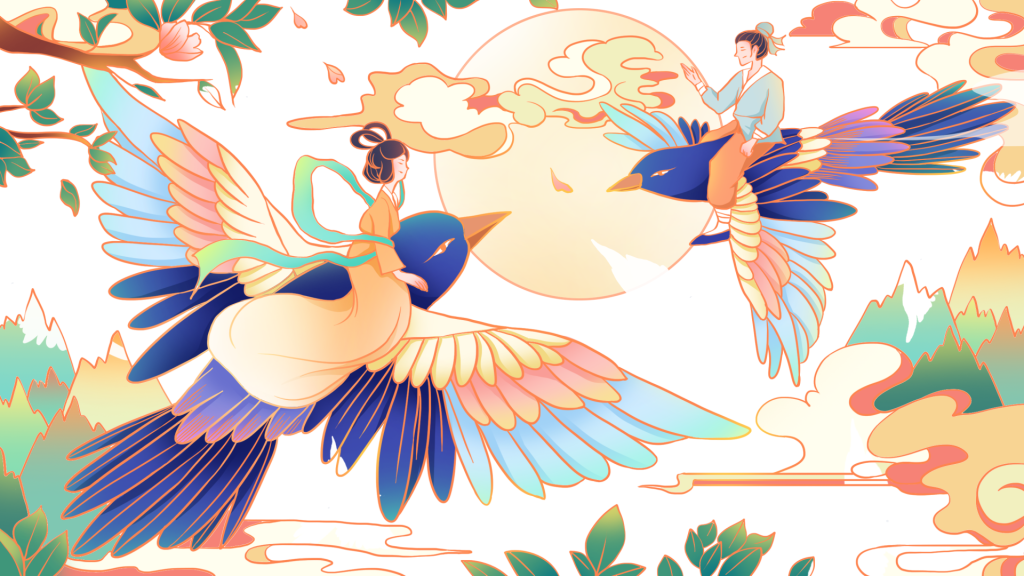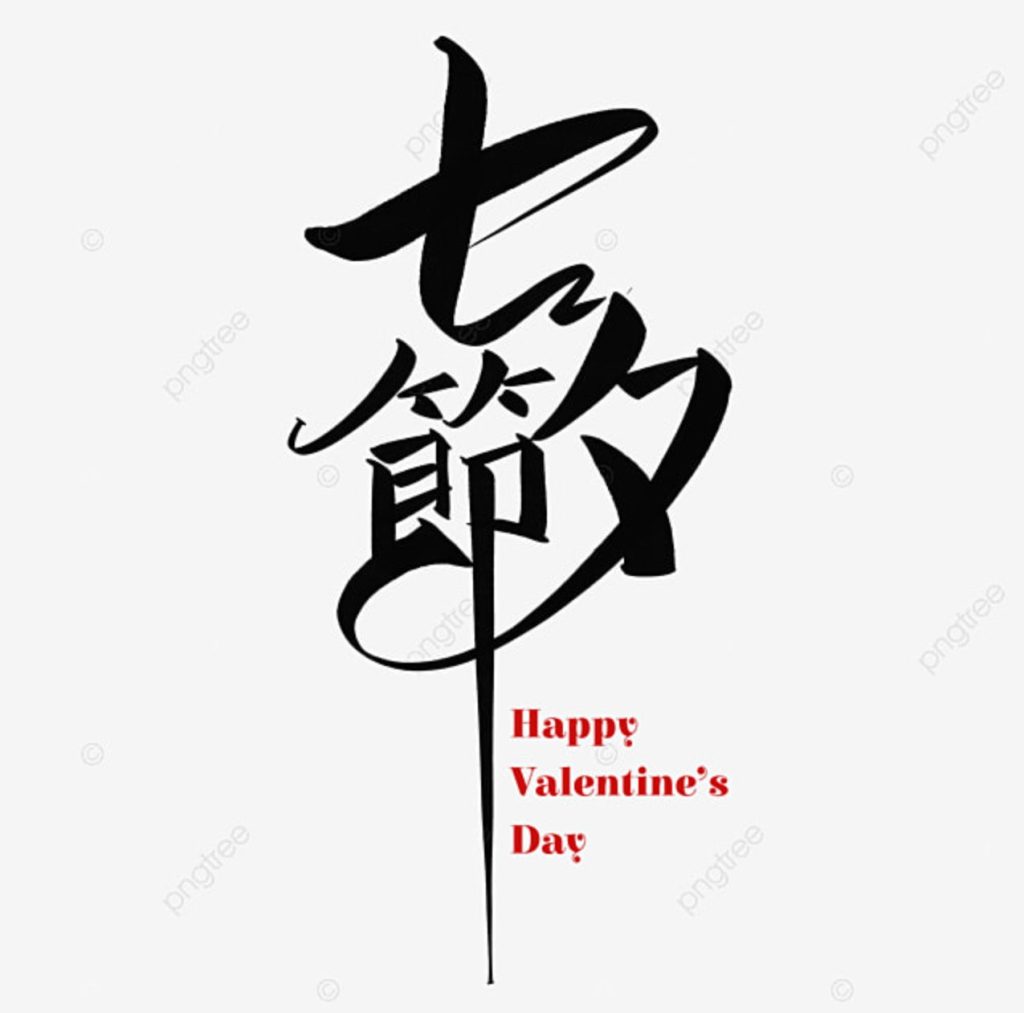Contents
Introduction:
Today is China’s Qixi Festival, a fascinating traditional Chinese festival dedicated to love. China’s Qixi is celebrated on the seventh day of the seventh lunar month, which this year falls on August 10th. When considering how to translate ‘Qixi Festival’ into English, the most appropriate terms are “Chinese Valentine’s Day” or “China Magpie Festival.” Another literal translation might be “Double Seventh Festival.” However, in my opinion, Chinese Valentine’s Day is the most fitting, as Qixi Festival has been celebrated in China for over 2,000 years, symbolizing the unwavering love and commitment between married couples. So, our story of the Chinese Valentine’s Day begins here.
Part 1: The Story of Chinese Valentine’s Day: The Cowherd and the Weaver Girl
A long time ago, there existed an invisible boundary between the heavens and the mortal world. The heavenly maidens lived peaceful lives in the celestial realm, while mortals toiled on earth. In a small village, there lived a young cowherd named Niulang, who was kind and hardworking. In the celestial realm, there was a maiden named Zhinu, responsible for weaving the clouds and starlight. She was beautiful and kind, but deep within, she longed for the genuine emotions found in the mortal world, rather than the mundane life in the heavens.
One day, Zhinu, along with other celestial maidens, descended to the mortal world. But this time, she did not wish to return to the heavens because she met Niulang. The moment they met, love blossomed between them. Niulang and Zhinu lived a simple yet happy life on earth. They became husband and wife and had two lovely children. However, when Zhinu’s grandmother, the Queen Mother of the West, discovered that her granddaughter had married a mortal, she took Zhinu back to the heavens and created a vast river of stars (the Milky Way) to separate the couple.
Niulang was heartbroken, but his old ox revealed a secret. The ox was not an ordinary animal but a celestial ox (the Altair star) who had been banished to the mortal world as punishment. The ox advised Niulang to make a pair of wings from its hide and fly to the heavens to reunite with Zhinu. Niulang did as he was told and, with his children, flew towards the Milky Way.
Just as Niulang was about to reunite with Zhinu, the Queen Mother of the West created a deep, insurmountable river in the Milky Way, completely cutting off their reunion. Niulang and Zhinu gazed at each other from opposite sides of the Milky Way, filled with longing and despair.
At that moment, thousands of magpies, moved by the couple’s tragic love story, flew to the heavens and formed a bridge with their bodies over the Milky Way. This bridge is known in legend as the ‘Magpie Bridge.’ Every year on the seventh day of the seventh lunar month, Niulang and Zhinu are able to meet on this bridge across the starry river.
This concludes the story. No matter what, every year on the Chinese Valentine’s Day (Qixi Festival)—the seventh day of the seventh lunar month—Niulang and Zhinu meet. They firmly believe that one day, this family, husband, wife, and children, will be together forever. That is what truly defines a family.
Part 2: The Origins of Chinese Valentine’s Day (Qixi Festival) and Ancient Star Worship
The origins of Chinese Valentine’s Day (Qixi Festival) are closely linked to ancient star worship and the reverence for time. This connection is deeply rooted in Chinese ancient culture, astronomy, the concept of time, and mythological legends. The legend of Qixi mainly stems from the story of Niulang and Zhinu. Astronomically, the Cowherd Star (Altair) and the Weaver Girl Star (Vega) are two bright stars located on opposite sides of the Milky Way. In ancient China, these two stars were personified, creating the myth of Niulang and Zhinu. Every year on the seventh day of the seventh lunar month, these two stars appear closest in the night sky, and it is said that this is the day when Niulang and Zhinu meet on the Magpie Bridge. Therefore, the origin of Qixi Festival is closely associated with the worship of these two stars.
- Astronomy and Agricultural Society:In ancient agricultural society, star constellations were used to guide farming activities. People planned their planting and harvesting based on the movement of stars. Therefore, the story of Niulang and Zhinu is not just a love legend but also reflects the ancient people’s observations of the stars and their respect for natural laws. This star worship symbolizes the harmonious relationship between humans and nature, making Qixi Festival an important occasion to express this connection.
- The Special Significance of the Seventh Day of the Seventh Lunar Month:Chinese Valentine’s Day (Qixi Festival) is celebrated on the seventh day of the seventh lunar month, a date that was considered to have special significance in ancient times. In the ancient Chinese calendar, the seventh day of the seventh month was seen as a time when “heaven and earth meet,” making it particularly suitable for rituals and prayers. On this night, the Cowherd and Weaver Girl stars are closest, symbolizing the closest connection between the mortal world and the celestial realm.
- The Concept of Unity between Heaven and Man:The story of Niulang and Zhinu in Chinese Valentine’s Day (Qixi Festival) also reflects the ancient Chinese philosophy of “unity between heaven and man.” The love story of mortals was able to move the celestial beings, ultimately receiving their protection and assistance. This harmonious relationship between heaven, earth, and humanity is an important concept in traditional Chinese culture, reflecting the ancient understanding of the cosmic order.
- Reverence for Time:Chinese Valentine’s Day (Qixi Festival) also embodies the ancient Chinese reverence for time. The seventh day of the seventh lunar month not only marks the time when Niulang and Zhinu meet but also symbolizes the beginning of autumn in the annual cycle. In ancient China, time was seen as a sacred force, and festivals were a way for people to express their reverence and gratitude for time. Chinese Valentine’s Day (Qixi Festival), as an important occasion, reflects the ancient people’s understanding of time and respect for the cycle of life.
Part 3: Qixi Festival—China’s Festival of Love for Married Couples
Qixi Festival, as China’s traditional Valentine’s Day, is not just a celebration of the love story between Niulang and Zhinu; it also includes a variety of cultural activities and deep cultural significance. Here are some traditional Qixi Festival activities and the cultural meanings they represent:
- Qiqiao Activities: The most famous activity during Qixi Festival is “Qiqiao” (begging for skills). In ancient times, young girls would pray to the Weaver Girl star on the night of Qixi, asking for dexterous hands and wisdom, hoping to be as skilled and clever as Zhinu. There were many ways to practice Qiqiao, including threading needles, embroidery, and other handicrafts, with the goal of showcasing and improving their skills.
- Worshipping Zhinu: On the night of Qixi Festival, many families, especially young unmarried women, would set up a simple altar to worship the Weaver Girl star. They would place fruits, flowers, and other offerings on the altar, praying sincerely for a good marriage or skillful hands.
- Stargazing and Building Magpie Bridges: On the night of Qixi, people would look up at the night sky to observe the Cowherd and Weaver Girl stars, imagining them gazing at each other from across the Milky Way. In some places, people would even build “Magpie Bridges” out of grass or other materials to symbolize the reunion of Niulang and Zhinu across the bridge. These symbolic activities add a romantic atmosphere to the festival.
- Skill Competitions: In some regions, Qixi Festival includes “skill competitions” where participants showcase their abilities in embroidery, weaving, paper-cutting, and other crafts. These competitions are not only a display of craftsmanship but also reflect people’s pursuit of a better life.
- Releasing Lotus Lanterns: In some areas, there is a tradition of releasing lotus lanterns. People place lanterns in rivers or ponds, letting them drift with the water, symbolizing that the light of love can cross the darkness and find its way.
- Women’s Wisdom and Craftsmanship: Qixi Festival is also known as Qiqiao Festival, a day that particularly highlights the intelligence and craftsmanship of women. Qiqiao activities were mainly popular among ancient women, especially young girls. They would participate in various activities on the night of Qixi, praying to the Weaver Girl star (Zhinu) for skillful hands and wisdom. The activities included threading needles, embroidery, and weaving, aiming to showcase and improve their skills.
Conclusion:
Although today’s Chinese youth may find American Valentine’s Day more appealing, in the long memory of history, Chinese Valentine’s Day (Qixi Festival) truly represents the deep affection and companionship between husband and wife. Perhaps every couple in life will face various challenges beyond imagination, and their choices cannot always predict the future. Sometimes, these choices even lead to unforeseen sadness. However, I believe that true couples will choose to understand and love each other, living a peaceful life together!
Published by: Mr. Leo Mao. You are welcome to share this article, but please credit the author and include the website link when doing so. Thank you for your support and understanding.




